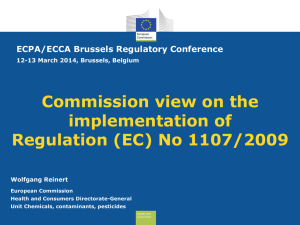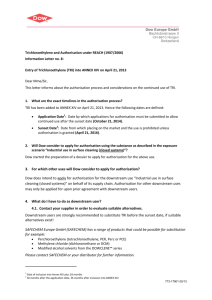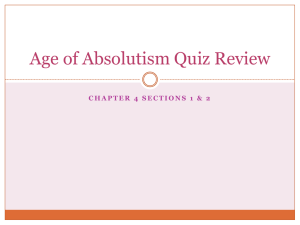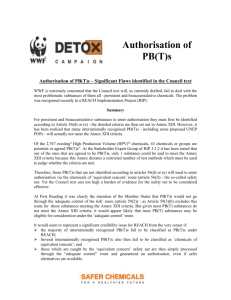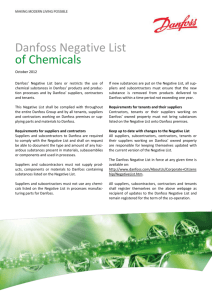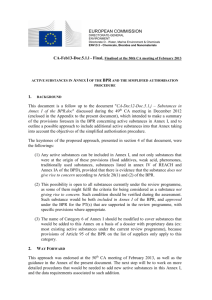Call for information (on behalf of the Commission) - ECHA
advertisement
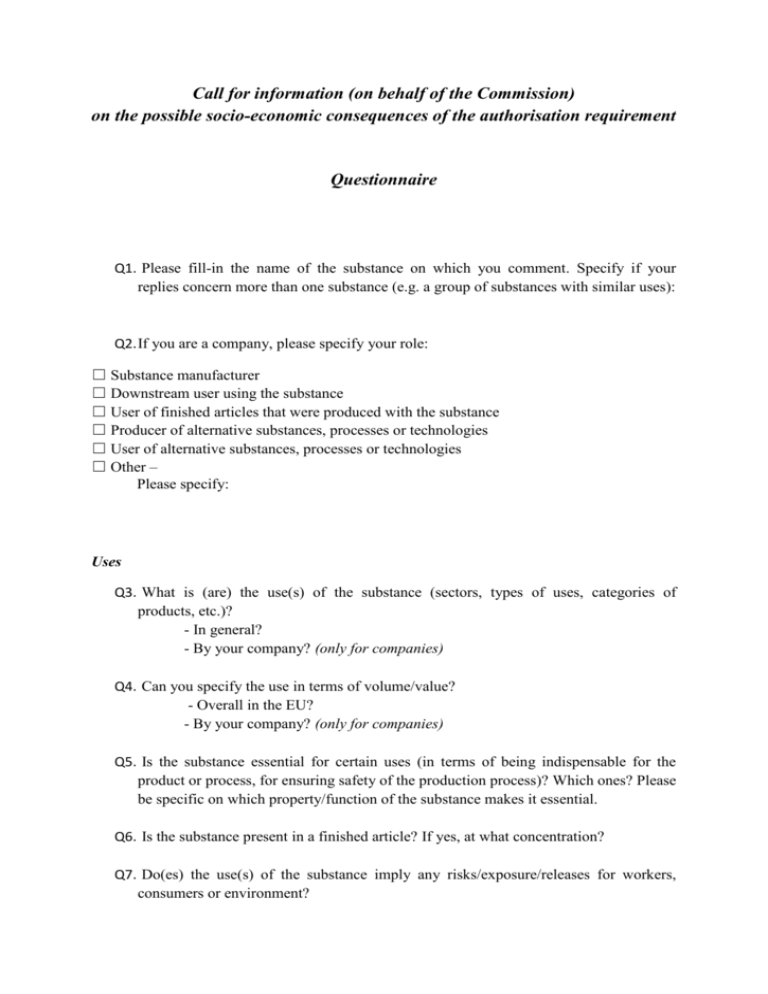
Call for information (on behalf of the Commission) on the possible socio-economic consequences of the authorisation requirement Questionnaire Q1. Please fill-in the name of the substance on which you comment. Specify if your replies concern more than one substance (e.g. a group of substances with similar uses): Q2. If you are a company, please specify your role: ☐ Substance manufacturer ☐ Downstream user using the substance ☐ User of finished articles that were produced with the substance ☐ Producer of alternative substances, processes or technologies ☐ User of alternative substances, processes or technologies ☐ Other – Please specify: Uses Q3. What is (are) the use(s) of the substance (sectors, types of uses, categories of products, etc.)? - In general? - By your company? (only for companies) Q4. Can you specify the use in terms of volume/value? - Overall in the EU? - By your company? (only for companies) Q5. Is the substance essential for certain uses (in terms of being indispensable for the product or process, for ensuring safety of the production process)? Which ones? Please be specific on which property/function of the substance makes it essential. Q6. Is the substance present in a finished article? If yes, at what concentration? Q7. Do(es) the use(s) of the substance imply any risks/exposure/releases for workers, consumers or environment? Q8. What measures have been put in place to prevent these risks/exposure/releases? Availability of alternatives Q9. Are there alternative substances, processes or technologies currently available for the use(s) of the substance? If yes, what are these alternatives and, what are their hazard properties compared to the substance in question? Q10. Would the use of this (these) alternative(s) substances, processes or technologies lead to a more sustainable production/ a more sustainable consumption? Q11. Are you aware of their use/testing? - In the EU or in non-EU countries? - By your company? (only for companies) Q12. Are you planning to substitute the substance in the coming five years? (Only for companies) Q13. Are there uses for which there are no alternatives (substances, processes or technologies)? Q14. If there are no alternatives, are you aware of any R&D work in attempt to develop them? If so, how long do you expect that the development / testing can take? - In the EU or in non-EU countries? - By your company? (only for companies) Market and Supply Chain Q15. What is the volume/value of the substance that is placed on the EU market/manufactured in the EU/ imported into EU/ exported from EU (per annum), or, used? - Overall in the EU? - By your company? (only for companies) Q16. Linked to Q14, please specify the sector in which you are using the substance and describe the supply chain where the substance is used. (only for companies) Q17. Linked to Q14 and 15, can you provide data on the turnover of the concerned sectors and the number of people employed? What is the turnover of the substance/substance-related products vs. the total turnover of the sector? Q18. Can you estimate the relative weight of SMEs in the concerned sectors (in terms of number of companies and employment) in your country /in the EU? 2 Q19. Are the manufacturers of the substance or downstream users concentrated in a single/limited number of Member States or in a limited number of regions? Competitiveness Q20. What would be or has been the overall costs of substitution for the particular use you are providing information on or you are involved in (including if relevant the need of changes in the production process, need for new product testing and certification) and to how long period this cost would be or has been spread? Q21. What is the expected impact of substitution costs on the costs of your inputs or final products? What is expected impact on your sales in the EU/outside the EU countries. (only for companies) Q22. Please describe what the impacts of including the substance in Annex XIV of REACH would be? (in terms of changes in the competitive position with respect to non-EU competitors on the EU market and on third markets) - To the concerned sectors? - To your company? (only for companies) Other impacts of inclusion in Annex XIV (innovation and business opportunities) Q23. If the substance is included in Annex XIV to be eventually phased out, would it create business opportunities (e.g. higher market share, development of alternative substances /products / production techniques)? - In your sector? - For your company? (only for companies) Q24. What effects do you expect on enterprises’ capacity to innovate? (The capacity to produce more efficiently and/or higher quality and a larger scale of products and services and the capacity to bring R&D to the market) Q25. Are you aware of any likely effects on recycling /the sustainable use of byproducts? Application for authorisation – (only for industry actors) Q26. If the substance is included in Annex XIV, would you consider applying for an authorisation? In case of negative answer, are you aware if your suppliers/downstream users consider to apply? Q27. How would you envisage that the submission of an application for authorisation could be organised, considering your/the specific uses and the structure 3 of the supply chain: would you envisage an application by manufactures/importers of the substance or formulators (upstream the supply chain)/ or application by downstream users or a combination of all)? Q28. What main challenges in preparing an application do you expect for your specific case? Would you envisage applying for your own uses or would you apply to cover uses of your downstream users? Q29. Do you see a potential for simplification or streamlining of the application with respect to some of the uses?1 Regulatory options Q30. Do you consider that other regulatory options could better address the concerns for which the substance is recommended for inclusion in Annex XIV? What are these regulatory options? Explain why? Other remarks Q31. Would you like to provide additional comments/information on the possible socio-economic impacts? ***** 1 For example, uses in low quantities, or in legacy spare parts (simplification) or controlled use in a closed process (streamlining). For information on streamlining and simplification of the authorisation process, see a discussion paper of the Commission (CA/16/2015) on http://ec.europa.eu/growth/sectors/chemicals/reach/about/index_en.htm 4



